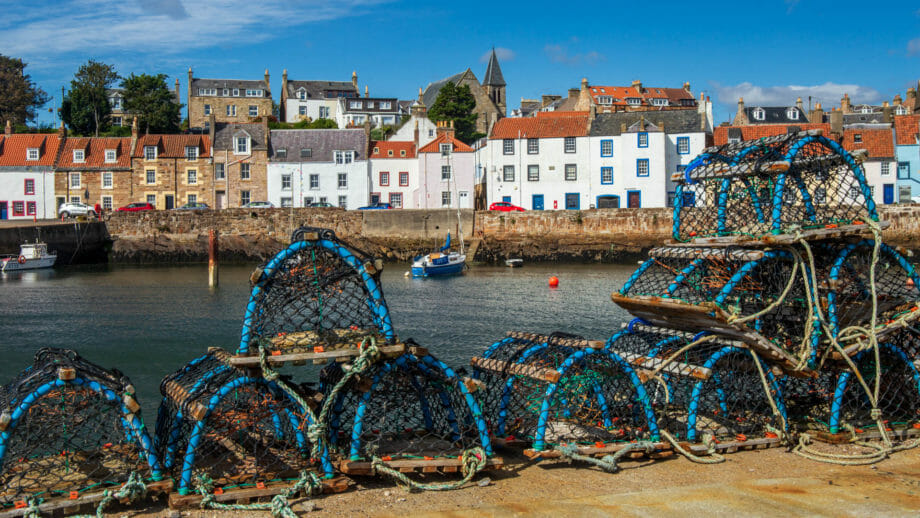The coast of the Kingdom of Fife is peppered with charming fishing villages. St Monans, with its Gothic church, stands out once again.

Similar to Crail or Pittenweem, St Monans is made up of old houses with red-tiled roofs that line the picturesque fishing harbour. Fishing baskets rest on the quay wall and small fishing boats anchor behind them in the sheltered water. A true idyll.
On the way from Edinburgh up the east coast to St Andrews and on to Dundee, St Monans makes a really nice stop and a refreshing walk. Along the coast, to the east, you can visit the windmill, and the salt extraction ponds. And to the west, the gothic St Monans Church.
There is much to discover here. One very special place is the “Welly Boot Garden.” Here, teacher Win Brown has conjured a garden out of the old rubber boots of her grandchildren and some of her students. Flowers now thrive in the boots, and they are surrounded by rocks and miniatures.
Of course, the harbour with its enclosing wall is an attraction in itself.
Walking right up to the harbour exit, you catch a wonderful view of the facades of the harbour front.
Finally, at the west end of the village is St Monans Church, surrounded by an old graveyard.
Some parts of the church are said to date back as far as the 14th century, when King David II of Scotland. Legend has it that he endowed a chapel here after being shipwrecked here but escaping with his life.
The church is now considered the place of worship closest to the sea in Scotland. There is only 20 yards between the sea and the building, and several graves.
Know: The Name St Monans and the History
For those wondering about the name: It is actually an abbreviated form of the name of a saint – St Monance. He is said to have been martyred here in the 9th century during an attack by the Danes – along with some 6,000 other Christians and one other saint.
He is said to have been buried here in a shrine, and the first church was built in his honor. Even though the current church dates back to the time of King David II, it has been expanded and overhauled time and again – most recently in 2007.
Over the centuries St Monans has been transformed into a successful fishing port. Three piers were built over time as more and more ships docked here. The central pier dates back to the 16th century. The eastern pier was added in 1865 and the western pier in 1900.
Not only were fish caught and shipped on, but salt was also extracted from seawater in pools near the windmill – the facilities can still be seen.
Today, St Monans in East Neuk is also an interesting stop for anyone walking along the Fife Coastal Path.
Directions:
With navigation device: enter “KY10 2BJ” and follow the instructions.
Without sat nav: From Edinburgh, head north on the M90 for a short while, but then immediately take the exit at Inverkeithing onto the Fife Coastal Road East. This is not the fastest route, but it is the nicest for tourists. On this A921 it goes now always up to Dystart – there further on the A955 and later briefly on the A915. In Upper Largo make sure that you go straight on the Coastal Road again and NOT to St Andrews, but to Crail. The A917 now to Elie and eventually to St Monans.
Parking is possible at the harbour if there is space available.